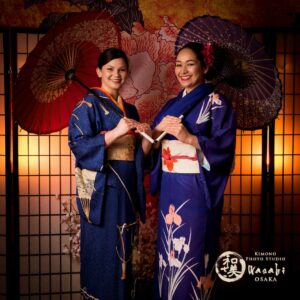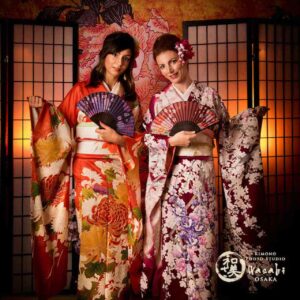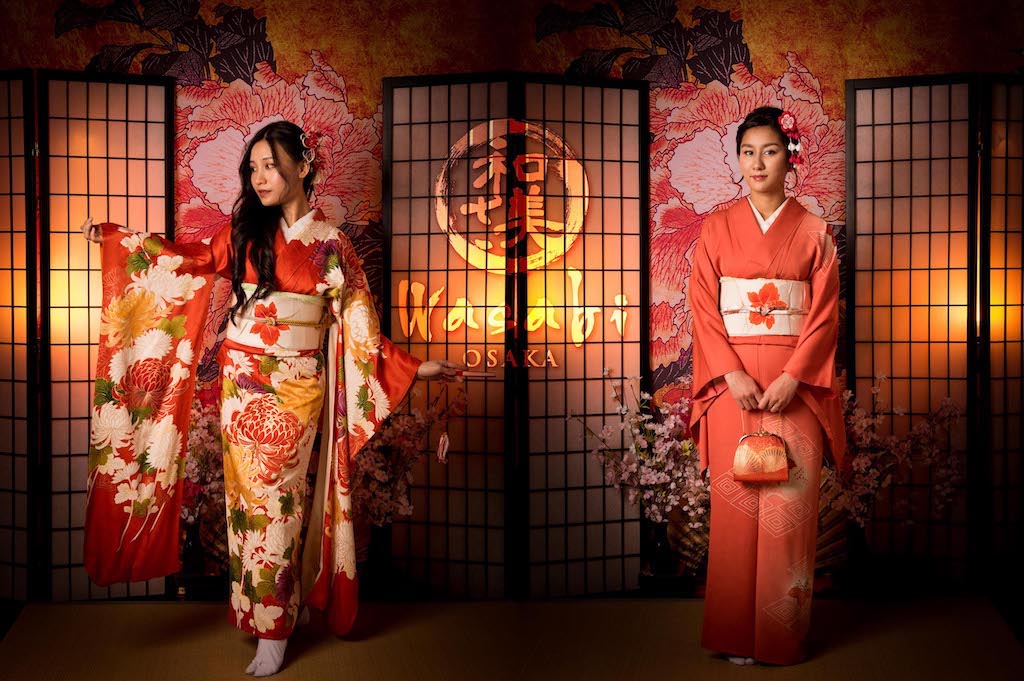At a first glance, a kimono looks beautiful. In any colour or design, with an obi belt and/or wooden geta sandals. They’re gorgeous.
Once a kimono’s caught your eye, you’ll want to know more about this traditional Japanese clothing. There’s a lot to discover. How many styles are there? Do the colours and patterns mean anything? When should a kimono be worn? And can anyone wear a kimono, or are there rules?

We’ve collected a lot of authentic silk kimonos at our photo studio. So we’ve come to know both the obvious and subtle differences between different types of kimono.
‘Kimono’ and ‘furisode’: a Japanese kanji lesson
Put simply, ‘kimono’ (着物) is the generic name. It’s literally ‘something you wear’. A ‘furisode’ is just 1 style of kimono, out of many, and we’ll focus on it for this post.
In Japanese, the word ‘furisode’ (振袖) means ‘swinging sleeves’. The first kanji, ‘furi’ (振), is the ‘swing’ bit, and ‘sode’ (袖) is the word for sleeve. (You’ll also see this ‘sleeve’ kanji if you’re shopping for T-shirts and tops in Japan.)
The easiest way to spot a furisode is to look at those sleeves. They’re long!
If a kimono has shorter sleeves than this, you know it’s some other style and not a furisode.
There are other differences, too. Where kimono sleeves are sewn to the body, a furisode’s sleeves hang loose. Furisode designs are also brighter and more colourful than standard kimono.
A brief history of the furisode style
Furisode are traditionally worn by younger (and often unmarried) women. At one point, they were a genderless outfit also worn by boys.
They’re a common sight at modern ‘Coming of Age Day’ ceremonies in Japan, when ladies celebrate reaching adulthood (20 years old). At Japanese weddings, some guests may also wear furisode instead of a dress.

The added material and unique designs can make buying a furisode expensive. As a result, many people get theirs from local kimono rental shops.
Back in the Edo period, the furisode was more than formal wear – it was how people were expected to dress. At borders, for example, young women who weren’t wearing furisode weren’t allowed in.
We say ‘roll up your sleeves’, Japan says ‘let your sleeves hang down’
Over time, the furisode sleeve length’s changed with Japanese fashions. By the mid-18th century, they were often more than a metre long!
That didn’t mean the sleeves got in the way – in fact, they served a purpose. The longer the sleeves, the more useful they were. Young ladies used their flowing furisode sleeves to communicate. Maybe to a crush: ‘I like you, so please come over here!’.
Swinging long sleeves around was also said to get rid of demons and purify the area. That brought the added benefits of luck and good health to everyone around.
Furisode sleeves are sewn shorter as the wearer gets older, or once they get married. And some women over 30 don’t wear furisode at all. On the other hand (other sleeve, maybe?), many women sport long furisode sleeves into their 30s and beyond – it’s become a common sight at photoshoots, and on special occasions.
Want to try wearing a traditional Japanese kimono or furisode?
Whenever you’re next in Osaka, make sure to visit Kimono Photo Studio Wasabi. We have a wide variety of kimono and furisode, so you can see the difference between each style for yourself.


